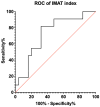Diagnosing Sarcopenia with AI-Aided Ultrasound (DINOSAUR)-A Pilot Study
- PMID: 39203903
- PMCID: PMC11357450
- DOI: 10.3390/nu16162768
Diagnosing Sarcopenia with AI-Aided Ultrasound (DINOSAUR)-A Pilot Study
Abstract
Background: Sarcopenia has been recognized as a determining factor in surgical outcomes and is associated with an increased risk of postoperative complications and readmission. Diagnosis is currently based on clinical guidelines, which includes assessment of skeletal muscle mass but not quality. Ultrasound has been proposed as a useful point-of-care diagnostic tool to assess muscle quality, but no validated cut-offs for sarcopenia have been reported. Using novel automated artificial intelligence (AI) software to interpret ultrasound images may assist in mitigating the operator-dependent nature of the modality. Our study aims to evaluate the fidelity of AI-aided ultrasound as a reliable and reproducible modality to assess muscle quality and diagnose sarcopenia in surgical patients. Methods: Thirty-six adult participants from an outpatient clinic were recruited for this prospective cohort study. Sarcopenia was diagnosed according to Asian Working Group for Sarcopenia (AWGS) 2019 guidelines. Ultrasonography of the rectus femoris muscle was performed, and images were analyzed by an AI software (MuscleSound® (Version 5.69.0)) to derive muscle parameters including intramuscular adipose tissue (IMAT) as a proxy of muscle quality. A receiver operative characteristic (ROC) curve was used to assess the predictive capability of IMAT and its derivatives, with area under the curve (AUC) as a measure of overall diagnostic accuracy. To evaluate consistency between ultrasound users of different experience, intra- and inter-rater reliability of muscle ultrasound parameters was analyzed in a separate cohort using intraclass correlation coefficients (ICC) and Bland-Altman plots. Results: The median age was 69.5 years (range: 26-87), and the prevalence of sarcopenia in the cohort was 30.6%. The ROC curve plotted with IMAT index (IMAT% divided by muscle area) yielded an AUC of 0.727 (95% CI: 0.551-0.904). An optimal cut-off point of 4.827%/cm2 for IMAT index was determined with a Youden's Index of 0.498. We also demonstrated that IMAT index has excellent intra-rater reliability (ICC = 0.938, CI: 0.905-0.961) and good inter-rater reliability (ICC = 0.776, CI: 0.627-0.866). In Bland-Altman plots, the limits of agreement were from -1.489 to 1.566 and -2.107 to 4.562, respectively. Discussion: IMAT index obtained via ultrasound has the potential to act as a point-of-care evaluation for sarcopenia screening and diagnosis, with good intra- and inter-rater reliability. The proposed IMAT index cut-off maximizes sensitivity for case finding, supporting its use as an easily implementable point-of-care test in the community for sarcopenia screening. Further research incorporating other ultrasound parameters of muscle quality may provide the basis for a more robust diagnostic tool to help predict surgical risk and outcomes.
Keywords: artificial intelligence; intramuscular adipose tissue; muscle quality; sarcopenia; ultrasound.
Conflict of interest statement
Paul E. Wischmeyer reports receiving investigator-initiated grant funding from National Institutes of Health, Department of Defense, Abbott Nutrition, Baxter, and Fresenius. Paul E. Wischmeyer has served as a consultant to Abbott Nutrition, Fresenius, Baxter, Mend Inc., and Nutricia for nutrition research. Paul E. Wischmeyer has received unrestricted gift donations for nutrition research from MuscleSound and DSM. Paul E. Wischmeyer has received honoraria or travel expenses for CME lectures on improving nutrition care from Abbott Nutrition, Baxter, Danone-Nutricia, Mend, and Nestlé. Jeroen Molinger reports receiving research funding from MuscleSound and Nutricia. Jeroen Molinger has received honoraria or travel expenses for CME lectures on improving nutrition and perioperative care from Abbott Nutrition, Baxter, Danone-Nutricia, Nestlé, and MuscleSound. The sponsors had no role in the design, execution, interpretation, or writing of the study. The other authors declare no conflicts of interest.
Figures




Similar articles
-
Ultrasound muscle assessment for sarcopenia detection in inflammatory bowel disease: A prospective study.United European Gastroenterol J. 2024 Jun;12(5):562-573. doi: 10.1002/ueg2.12566. Epub 2024 Mar 28. United European Gastroenterol J. 2024. PMID: 38549182 Free PMC article.
-
Evaluation of Appendicular Muscle Mass in Sarcopenia in Older Adults Using Ultrasonography: A Systematic Review and Meta-Analysis.Gerontology. 2022;68(10):1174-1198. doi: 10.1159/000525758. Epub 2022 Jul 25. Gerontology. 2022. PMID: 35878591 Free PMC article.
-
Ultrasound Cut-Off Values for Rectus Femoris for Detecting Sarcopenia in Patients with Nutritional Risk.Nutrients. 2024 May 21;16(11):1552. doi: 10.3390/nu16111552. Nutrients. 2024. PMID: 38892486 Free PMC article.
-
Cut-off Values for Lower Limb Muscle Thickness to Detect Low Muscle Mass for Sarcopenia in Older Adults.Clin Interv Aging. 2021 Jun 25;16:1215-1222. doi: 10.2147/CIA.S304972. eCollection 2021. Clin Interv Aging. 2021. PMID: 34211270 Free PMC article.
-
The Diagnostic Value of Ultrasound of the Rectus Femoris for the diagnosis of Sarcopenia in adults: A systematic review.Injury. 2022 Nov;53 Suppl 3:S23-S29. doi: 10.1016/j.injury.2022.06.004. Epub 2022 Jun 15. Injury. 2022. PMID: 35732560
Cited by
-
Artificial Intelligence in Orthopedic Surgery: Current Applications, Challenges, and Future Directions.MedComm (2020). 2025 Jun 25;6(7):e70260. doi: 10.1002/mco2.70260. eCollection 2025 Jul. MedComm (2020). 2025. PMID: 40567249 Free PMC article. Review.
-
Imaging Cancer-associated Cachexia: Utilizing Clinical Imaging Modalities for Early Diagnosis.Radiol Imaging Cancer. 2025 Jul;7(4):e240291. doi: 10.1148/rycan.240291. Radiol Imaging Cancer. 2025. PMID: 40476859 Free PMC article. Review.
-
Evaluating the Impact of Multimodal Prehabilitation with High Protein Oral Nutritional Supplementation (HP ONS) with Beta-Hydroxy Beta-Methylbutyrate (HMB) on Sarcopenic Surgical Patients-Interim Analysis of the HEROS Study.Nutrients. 2024 Dec 17;16(24):4351. doi: 10.3390/nu16244351. Nutrients. 2024. PMID: 39770973 Free PMC article.
-
Development of a deep learning model for predicting skeletal muscle density from ultrasound data: a proof-of-concept study.Radiol Med. 2025 Jul 8. doi: 10.1007/s11547-025-02047-2. Online ahead of print. Radiol Med. 2025. PMID: 40627283
References
-
- Chen L.K., Woo J., Assantachai P., Auyeung T.W., Chou M.Y., Iijima K., Jang H.C., Kang L., Kim M., Kim S., et al. Asian Working Group for Sarcopenia: 2019 Consensus Update on Sarcopenia Diagnosis and Treatment. J. Am. Med. Dir. Assoc. 2020;21:300–307.e2. doi: 10.1016/j.jamda.2019.12.012. - DOI - PubMed
-
- Teo J. Initiatives in Place to Tackle Ageing Issues as S’pore Hits ‘Super-Aged’ Status in 2026: Health Minister, in The Straits Times. SPH Media; Singapore: 2023.
MeSH terms
LinkOut - more resources
Full Text Sources

